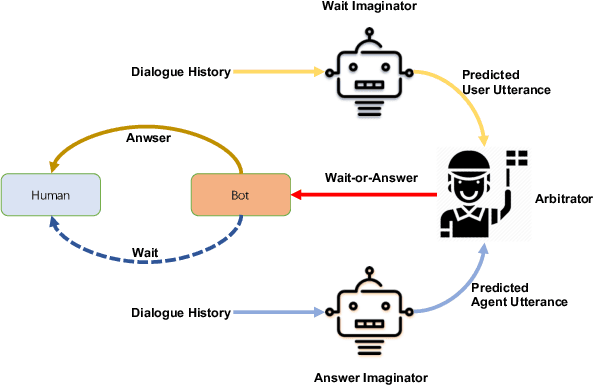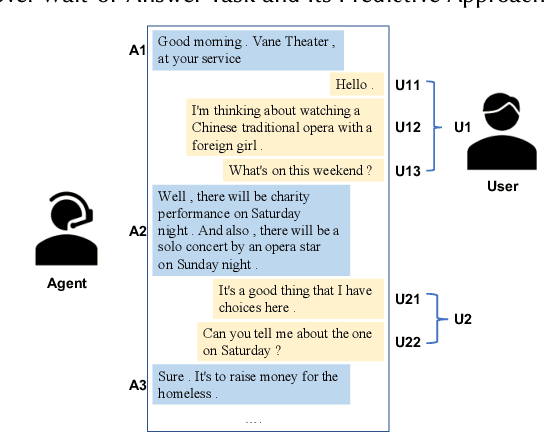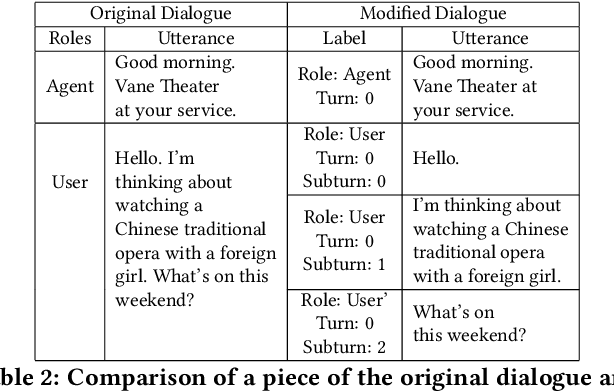Xiaoming Kang
Should Answer Immediately or Wait for Further Information? A Novel Wait-or-Answer Task and Its Predictive Approach
May 27, 2020



Abstract:Different people have different habits of describing their intents in conversations. Some people may tend to deliberate their full intents in several successive utterances, i.e., they use several consistent messages for readability instead of a long sentence to express their question. This creates a predicament faced by dialogue systems' application, especially in real-world industrial scenarios, in which the dialogue system is unsure that whether it should answer the user's query immediately or wait for users' further supplementary input. Motivated by such interesting quandary, we define a novel task: Wait-or-Answer to better tackle this dilemma faced by dialogue systems. We shed light on a new research topic about how the dialogue system can be more competent to behave in this Wait-or-Answer quandary. Further, we propose a predictive approach dubbed Imagine-then-Arbitrate (ITA) to resolve this Wait-or-Answer task. More specifically, we take advantage of an arbitrator model to help the dialogue system decide to wait or answer. The arbitrator's decision is made with the assistance of two ancillary imaginator models: a wait imaginator and an answer imaginator. The wait imaginator tries to predict what the user would supplement and use its prediction to persuade the arbitrator that the user has some information to add, so the dialogue system should wait. The answer imaginator, nevertheless, struggles to predict the answer of the dialogue system and convince the arbitrator that it's a superior choice to answer the users' query immediately. To our best knowledge, our paper is the first work to explicitly define the Wait-or-Answer task in the dialogue system. Additionally, our proposed ITA approach significantly outperforms the existing models in solving this Wait-or-Answer problem.
"Wait, I'm Still Talking!" Predicting the Dialogue Interaction Behavior Using Imagine-Then-Arbitrate Model
Feb 22, 2020



Abstract:Producing natural and accurate responses like human beings is the ultimate goal of intelligent dialogue agents. So far, most of the past works concentrate on selecting or generating one pertinent and fluent response according to current query and its context. These models work on a one-to-one environment, making one response to one utterance each round. However, in real human-human conversations, human often sequentially sends several short messages for readability instead of a long message in one turn. Thus messages will not end with an explicit ending signal, which is crucial for agents to decide when to reply. So the first step for an intelligent dialogue agent is not replying but deciding if it should reply at the moment. To address this issue, in this paper, we propose a novel Imagine-then-Arbitrate (ITA) neural dialogue model to help the agent decide whether to wait or to make a response directly. Our method has two imaginator modules and an arbitrator module. The two imaginators will learn the agent's and user's speaking style respectively, generate possible utterances as the input of the arbitrator, combining with dialogue history. And the arbitrator decides whether to wait or to make a response to the user directly. To verify the performance and effectiveness of our method, we prepared two dialogue datasets and compared our approach with several popular models. Experimental results show that our model performs well on addressing ending prediction issue and outperforms baseline models.
 Add to Chrome
Add to Chrome Add to Firefox
Add to Firefox Add to Edge
Add to Edge